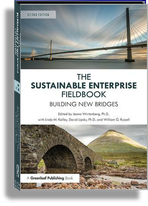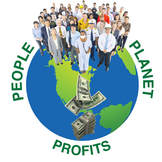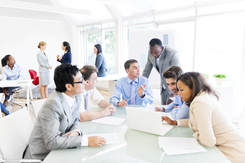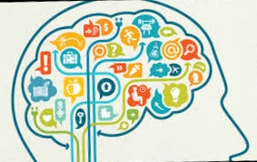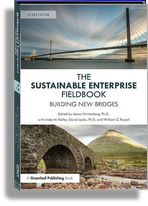CHAPTER ABSTRACTS
Introduction and overview
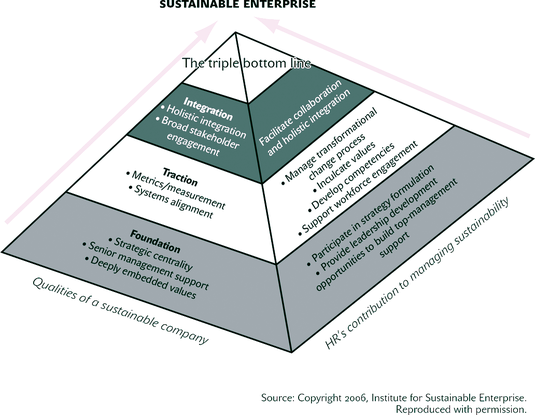
The purpose of the Fieldbook is to help forge a path to a better world and a more sustainable, flourishing and thriving future by supporting employees, managers, and leaders at every level and in every function, sector, and industry. We hope our readers will better understand sustainability, energize their commitment, and be empowered with the tools and techniques to improve their personal and enterprise sustainability performance in the short and long term. We put a sustainability lens on existing and new enterprise mechanisms to help us address the diverse needs of our audience. These include:
- Leadership for a sustainable enterprise
- Mental models for sustainability
- Developing a sustainability-aligned strategy
- Managing the change to a sustainable enterprise
- Employee engagement for a sustainable enterprise
- Sustainable enterprise metrics and measurement systems
- Sustainable globalization: the challenge and the opportunity
- Sustainability models for collaboration, technology, and community
- A path forward: building new bridges to the future
Chapter 1: Leadership for a sustainable enterprise
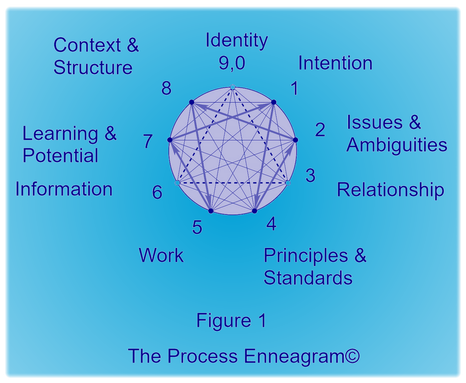
The aim of this chapter is to provide leaders with insights and examples of how transformation and change focused on building sustainable enterprise can be achieved in ways that produce superior results. Since the First Edition of this book important new insights from complexity science are having a profound impact on our understanding of how organizations actually work. We build on the concepts of Per Bak on Self-Organizing Criticality which are fundamental to understanding the importance of focused, purposeful, disciplined conversations, how change occurs, and the way energy and creativity are opened up and sustained.
In this context, the chapter focuses on the way leaders see themselves and choose to be in relation to each other, employees, customers, communities, the larger society, the environment, and other stakeholders. Leaders in sustainable enterprise choose to purposefully engage with the people inside the organization as if it were a living system, while recognizing that they are simultaneously operating in the larger ecosystem of the world. The essays in this holographic ensemble bring together many of the key features of leadership for sustainable enterprise We introduce a Leadership Diamond model, and five essays that breathe life into the model are shared. The Leadership Diamond model integrates the roles of leaders in relating and influencing through the power of enterprise intent and the embedded governing principles. It emphasizes the way of being that is so critical to sustainability. Another essay provides reflections on leadership from ancient traditions and Earth wisdom. A final essay provides a powerful framework for leading sustainable enterprise focused on the transformational power of listening.
In this context, the chapter focuses on the way leaders see themselves and choose to be in relation to each other, employees, customers, communities, the larger society, the environment, and other stakeholders. Leaders in sustainable enterprise choose to purposefully engage with the people inside the organization as if it were a living system, while recognizing that they are simultaneously operating in the larger ecosystem of the world. The essays in this holographic ensemble bring together many of the key features of leadership for sustainable enterprise We introduce a Leadership Diamond model, and five essays that breathe life into the model are shared. The Leadership Diamond model integrates the roles of leaders in relating and influencing through the power of enterprise intent and the embedded governing principles. It emphasizes the way of being that is so critical to sustainability. Another essay provides reflections on leadership from ancient traditions and Earth wisdom. A final essay provides a powerful framework for leading sustainable enterprise focused on the transformational power of listening.
Chapter 2: Mental Models for Sustainability
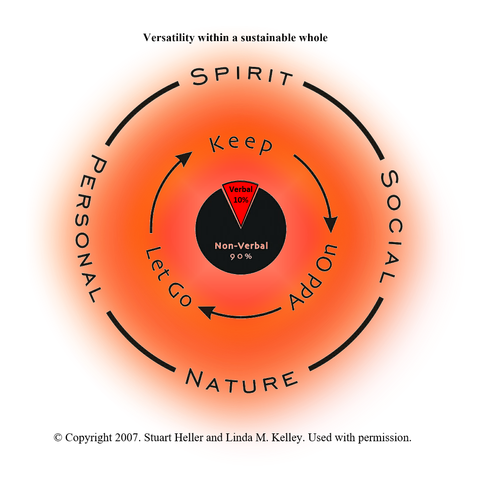
Chapter 2 focuses on the all-pervasive nature of the prevailing patterns of thought and shows the importance of becoming aware of the currently dominant models that reinforce wasteful and unsustainable behavior. The chapter recognizes that, for sustainable initiative to succeed, the leaders, managers, and staff of organizations and enterprises must incorporate recognition and appreciation of the larger dynamic complex systems of which they are a part. In this way they can consciously co-create more versatile, inclusive patterns of thinking and acting.
In this chapter, both theory and practices for making desired substantive changes in mental models are offered. John Adams’ framework lays out six dimensions for assessing and working with mental models, and comes out of his many years of research and consulting. To illustrate the difference that mental models make regarding the challenges and opportunities corporations encounter along the journey toward sustainability, examples are presented from two companies – one in the energy industry and one chemical company – that have transformed their thoughts and actions in response to the communities in which they are situated, Three case studies follow that provide tools and exercises for effecting mental model changes, as well as cultivating personal and group operating systems that support a high-quality, sustainable future.
In this chapter, both theory and practices for making desired substantive changes in mental models are offered. John Adams’ framework lays out six dimensions for assessing and working with mental models, and comes out of his many years of research and consulting. To illustrate the difference that mental models make regarding the challenges and opportunities corporations encounter along the journey toward sustainability, examples are presented from two companies – one in the energy industry and one chemical company – that have transformed their thoughts and actions in response to the communities in which they are situated, Three case studies follow that provide tools and exercises for effecting mental model changes, as well as cultivating personal and group operating systems that support a high-quality, sustainable future.
Chapter 3: Sustainability Aligned-Strategies

This chapter focuses on increasing “smart” systems-based sustainability-aligned enterprise strategies by combining the best of current core strategy development practices with sustainability-aligned enhancements. We review the current state of sustainable enterprise strategy with both a sobering assessment of our progress balanced with the enormous potential for a flourishing future. Government is not leading the movement and business is expected to do more. We also share a game-changing letter advocating every public company to have a clear strategy for Doing Well and Doing Good. We introduce our Smart Strategy Bridge framework with four stages to accelerate our progress towards a flourishing future. Each stage contains system-based actions we can take to improve our sustainable strategies. The Bridge progressions move enterprises from: Being Stuck, to Doing Well, to Doing Well and Doing Good, and finally to Thriving. Tools introduced include: a sustainability-enhanced SWOT, an ROI Workbook, and The Big Pivot. Case studies include: Small farmers in Haiti leveraging trees for profits, GE’s story of chasing the wrong purpose. Unilever and BASF are examples of integrating the SDGs within strategies for Doing Well and Doing Good. Interface and Tesla cases are examples of disruptive strategies that embrace risks and unknowns, but are driven by a purpose to help their enterprises and society to Thrive
Chapter 4: Managing Change to a Sustainable Enterprise
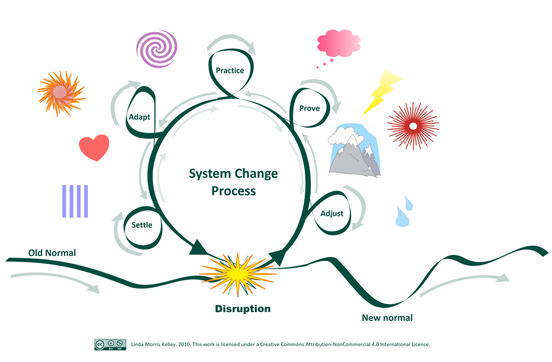
Our path and pace to creating a more sustainable and thriving world depends on our ability to change. We need to change our beliefs, capabilities and actions at an individual and enterprise level. This will require us to look, listen and move differently. Looking differently at sustainability opportunities and challenges will open up new paths and possibilities. Seeing the larger, complex system we are operating in will lead to smarter actions like managing paradoxes vs. attempting to solve problems that are impossible to solve. Listening authentically and openly to a broader set of stakeholders will generate increased collaboration and shared ownership. Opening up dialogue and feedback vehicles to multiple stakeholders will improve our triple bottom line (TBL): social equity, ecological integrity, and financial profitability. Moving forward every day and testing out new paths and possibilities will generate the progress and innovative approaches needed for success.
Chapter 5: Employee Engagement for a sustainable enterprise
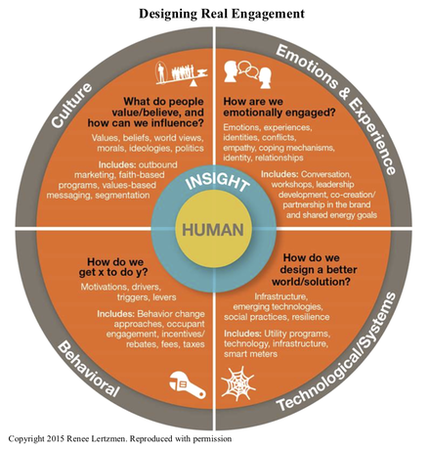
Chapter 5 looks at the importance of engaging employees at all levels in co-creating the enterprise’s future, a crucial accomplishment if even the most enlightened leaders are to get beyond their own best intentions. What approaches are recognized as necessary to involve employees in any major organizational change? What is unique about involving them in sustainability management?
This chapter suggests some of the psychological dynamics that contribute to achieving employees’ sense of ownership and commitment to taking on sustainability. It describes the power resulting from people experiencing autonomy and interdependence, and belonging to a community of kindred spirits. It describes how authentic leadership can resonate with people at all levels of an organization, as positive energy and resolve become contagious.
Five in-depth case studies illustrate distinctive approaches to employee engagement. One describes how senior management set up conditions for self-organizing at a previously underperforming plant at DuPont. Another case study elaborates on a multiyear effort to bridge labor and management differences to radically improve safety; yet another infused safety concerns through the constant drumbeat of companywide activities. Eileen Fisher lives out the keen social consciousness of its founder. Employee engagement even spreads across company lines when Eileen Fisher enlists management at overseas suppliers to improve working conditions for low-paid employees. Similarly, a grassroots effort in India paid dividends with social and environmental benefits for a whole community. Each situation exemplifies sound management concepts for unleashing the power, creativity, and insights made possible only by engaging a broad swath of the workforce.
This chapter suggests some of the psychological dynamics that contribute to achieving employees’ sense of ownership and commitment to taking on sustainability. It describes the power resulting from people experiencing autonomy and interdependence, and belonging to a community of kindred spirits. It describes how authentic leadership can resonate with people at all levels of an organization, as positive energy and resolve become contagious.
Five in-depth case studies illustrate distinctive approaches to employee engagement. One describes how senior management set up conditions for self-organizing at a previously underperforming plant at DuPont. Another case study elaborates on a multiyear effort to bridge labor and management differences to radically improve safety; yet another infused safety concerns through the constant drumbeat of companywide activities. Eileen Fisher lives out the keen social consciousness of its founder. Employee engagement even spreads across company lines when Eileen Fisher enlists management at overseas suppliers to improve working conditions for low-paid employees. Similarly, a grassroots effort in India paid dividends with social and environmental benefits for a whole community. Each situation exemplifies sound management concepts for unleashing the power, creativity, and insights made possible only by engaging a broad swath of the workforce.
Chapter 6: ENTERPRISE sustainability metrics and REPORTING
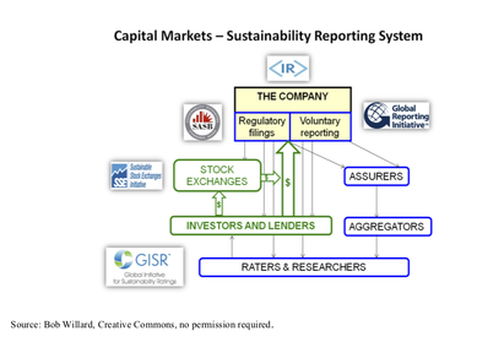
This chapter is about creating sustainability-aligned metrics and reporting systems that inform and monitor progress towards the “smart” sustainability-aligned Bridge strategy objectives presented in Chapter 3. Systems thinking is used to establish appropriate measurement boundaries and feedback signals. This requires establishing sustainability-aligned and stage appropriate S.M.A.R.T. goals. We introduce a multi-capital framework for measuring stock, flow and threshold performance. Sustainability is integral to the core business and so there is only one strategy and one integrated measurement and reporting systems that is enhanced and adapts as the enterprise strategy and performance progresses.
Measurement and reporting system design criteria, collaborations, tools and case examples are presented for each of the four smart Bridge strategy stages. Doing stage companies realize how much they are already doing. Doing Well is the stage most sustainability-engaged companies are at today. Their performance management and reporting systems showcase competitor differentiation and optimize financial performance and value. Doing Well and Doing Good stage companies are implementing all prior stage performance objectives, but cannot become complacent. Their systems need to progress to be more holistic and interconnected with societal goals. Thriving stage companies are pioneering science-based measurement systems and collaborating to devise context-based allocation schemes that are ethical and fair. These companies are starting to advance their enterprises and industries holistically to contribute to a thriving, flourishing society and world.
Measurement and reporting system design criteria, collaborations, tools and case examples are presented for each of the four smart Bridge strategy stages. Doing stage companies realize how much they are already doing. Doing Well is the stage most sustainability-engaged companies are at today. Their performance management and reporting systems showcase competitor differentiation and optimize financial performance and value. Doing Well and Doing Good stage companies are implementing all prior stage performance objectives, but cannot become complacent. Their systems need to progress to be more holistic and interconnected with societal goals. Thriving stage companies are pioneering science-based measurement systems and collaborating to devise context-based allocation schemes that are ethical and fair. These companies are starting to advance their enterprises and industries holistically to contribute to a thriving, flourishing society and world.
Chapter 7: sustainable globalization
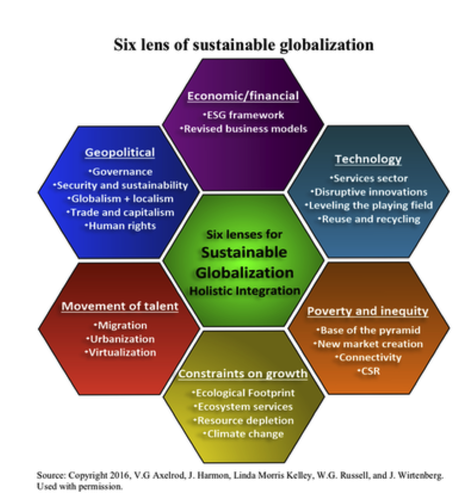
Chapter 7 represents a breakthrough and a fundamental transformation in how we approach doing business in a global world in the 21st century. The authors use six lenses of sustainable globalization to provide fresh perspectives on global issues:
● Economic/financial
● Technology
● Poverty and inequity
● Limits to growth
● Movement of talent
● Geopolitical
An emphasis on systemic multidisciplinary approaches is encouraged because of the complex and interconnected nature of the challenges facing the world today. Opportunities for sustainable globalization are introduced in case studies. The six lenses sustainable globalization tool provides readers with a means to assess the degree to which their organization is addressing each of the six lenses.
● Economic/financial
● Technology
● Poverty and inequity
● Limits to growth
● Movement of talent
● Geopolitical
An emphasis on systemic multidisciplinary approaches is encouraged because of the complex and interconnected nature of the challenges facing the world today. Opportunities for sustainable globalization are introduced in case studies. The six lenses sustainable globalization tool provides readers with a means to assess the degree to which their organization is addressing each of the six lenses.
Chapter 8: sustainability models for collaboration, technology, and community
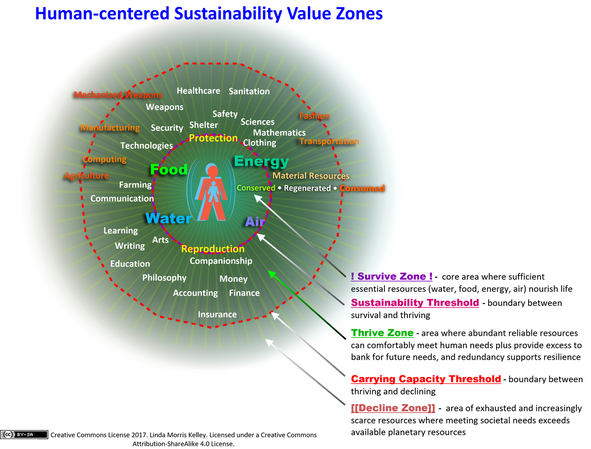
Chapter 8 focuses on ways we can invent our sustainable future, with particular attention to the importance of collaboration, technology, and community. The Chapter explores enterprises as complex systems operating in dynamic and increasingly unpredictable environments that include ecological disruption and social change.
Drawing on lessons from the past and realistic assessments of where we are today, the Chapter explores areas that are critical to inventing future sustainability for business and for society. Those are:
Drawing on lessons from the past and realistic assessments of where we are today, the Chapter explores areas that are critical to inventing future sustainability for business and for society. Those are:
- Integrated thinking
- Leadership and our complex networks of relationships including public-private collaborations
- Architecting participation
- Technology and ensuring the sustainability of essential resources
Chapter 9: Building new bridges to the future
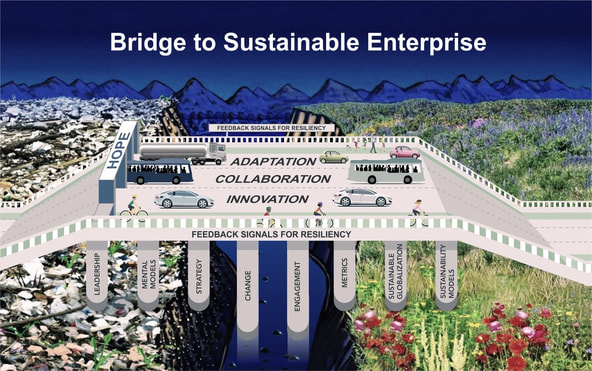
This closing chapter focuses on our key learnings, hope for the future, and recommendations for activating sustainable actionto achieve a thriving future. We share key barriers that keep us stuck and unableto make progress. We then cover ten positives, driving forces for change. These allow us to change the way we look many of our challenges and see new opportunities that we can leverage to make progress across the bridge of sustainability.
Learn more on Activities, Cases, Tools and Supplemental Resources within individual Chapter Pages
